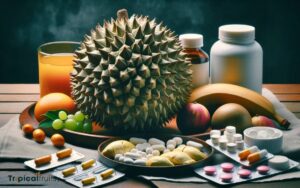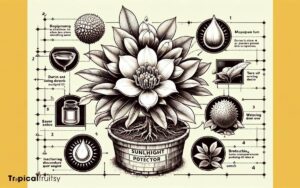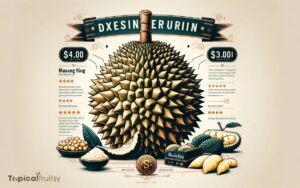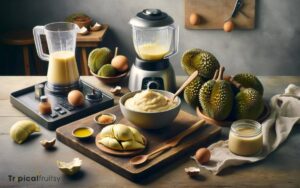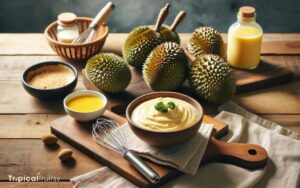Is Durian the Smelliest Fruit? Unveiling the Pungent King!
Yes, durian is often referred to as the smelliest fruit in the world. Its aroma is so strong and distinctive that it can be divisive among those who encounter it. The fruit’s smell is complex, described by some as a combination of various intense odors.
Durian’s potent smell is attributed to its unique composition of volatile sulfur compounds, which are released as the fruit matures.
These compounds include:
The perception of durian’s odor is subjective and can vary greatly among individuals. Some people are attracted to its rich, custardy taste despite the smell, while others are repelled by the odor alone.
The durian’s scent is unforgettable, earning it both adoration and infamy across the globe.
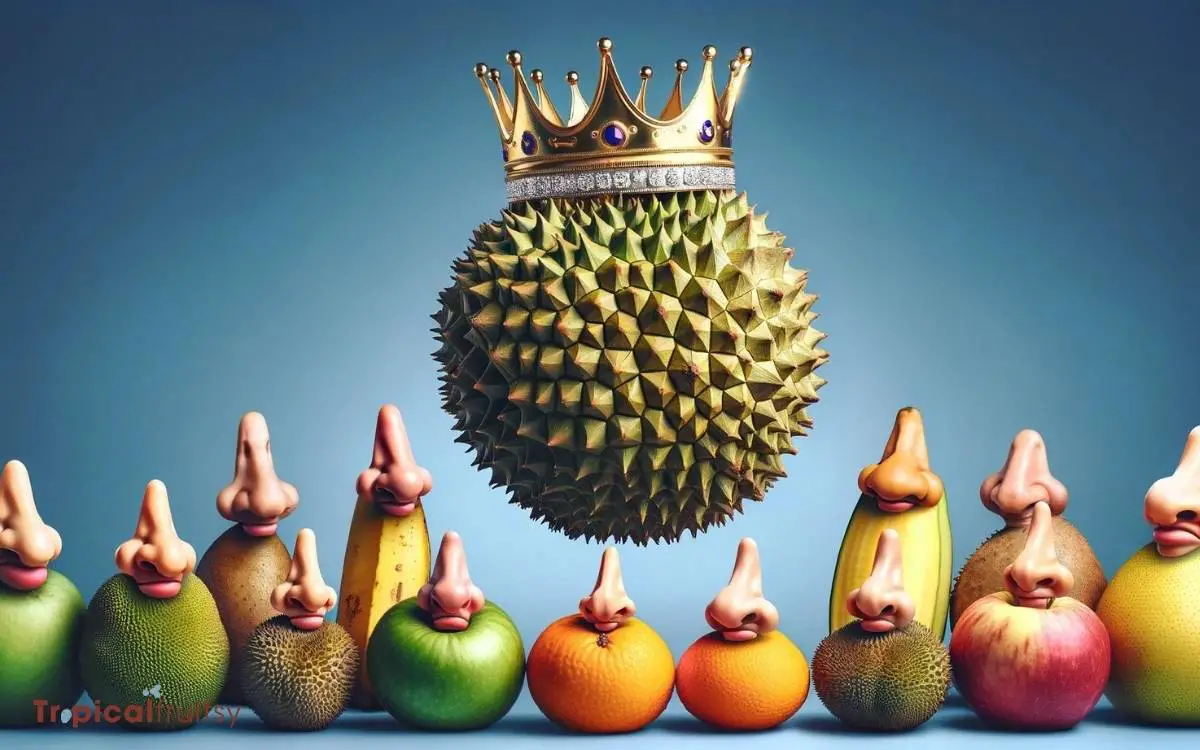
Key Takeaway
Durian Odor Profile: Understanding the World’s Smelliest Fruit
| Compound | Odor Description | Impact on Overall Smell |
|---|---|---|
| Ethyl (2S)-2-methylbutanoate | Fruity, sweet | Contributes to sweetness |
| 1-(ethylsulfanyl)ethane-1-thiol | Roasted onions, sulfuric | Adds savory depth |
| Methanethiol | Rotten cabbage, strong sulfuric | Responsible for pungency |
The Infamous Aroma of Durian
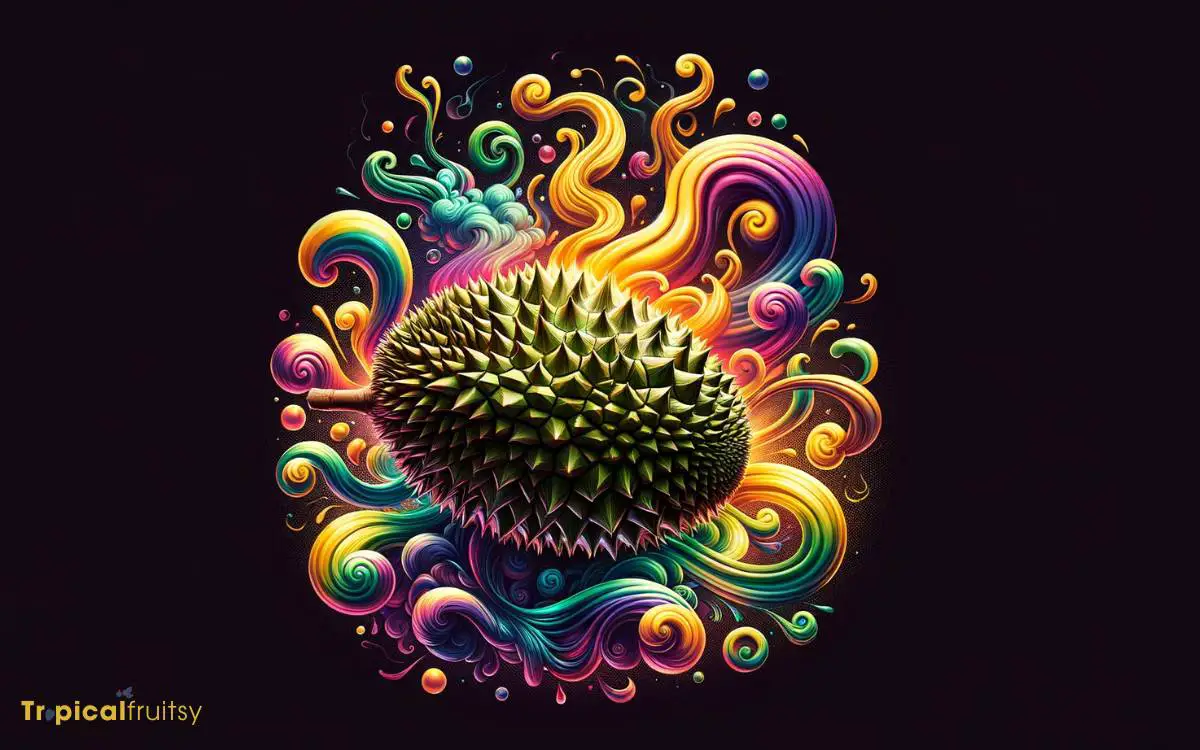
Durian’s odor, often likened to rotten onions or raw sewage, has earned it the title of the world’s smelliest fruit among many cultures.
Scientific analysis reveals that the pungent scent is a complex amalgamation of volatile compounds, including esters, ketones, and alcohols. These compounds are by-products of metabolic processes within the fruit as it ripens.
The intensity and composition of the odoriferous compounds vary not only between different durian species but also due to environmental factors influencing the fruit’s maturation.
This variability leads to a spectrum of reactions, ranging from deep appreciation to intense aversion.
The biochemical basis of the durian’s distinctive aroma is an exemplar of how intricate plant biochemistry can have wide-ranging sensory and cultural impacts.
Cultural Significance and Perceptions

Transcending its notorious scent, durian holds a revered place in Southeast Asian culture, where it is often celebrated as the ‘king of fruits’ and incorporated into various culinary traditions and social practices.
Despite its polarizing aroma, durian is deeply ingrained in the region’s identity, symbolizing not just a food preference but also a cultural heritage that locals take pride in.
This cultural significance is multifaceted and can be analyzed through various lenses:
- The fruit’s presence at festive occasions, marking moments of joy and togetherness.
- Durian’s role in strengthening community bonds, as sharing this delicacy is seen as an act of camaraderie.
- The symbolism of durian in local art and literature, reflecting its status in the cultural psyche.
An objective examination of durian’s cultural impact reveals a complex interplay between sensory experience and social meaning.
Scientific Explanation of the Scent
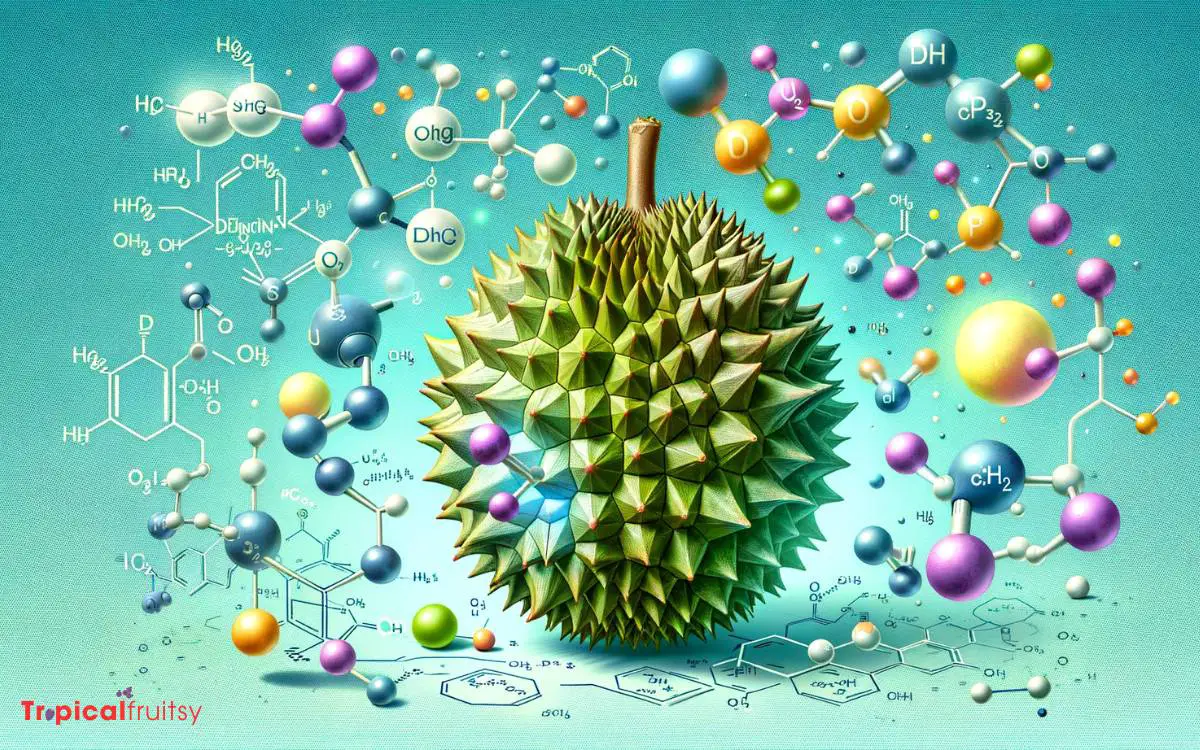
The scent of durian is primarily attributed to its composition of volatile sulfur compounds, which are known for their potent odor.
Chemical analysis of the odor has identified a complex mixture of esters, ketones, and alcohols, each contributing to the fruit’s distinctive smell.
Understanding the molecular structure and volatility of these compounds provides insight into why the scent of durian can be so pervasive and intense.
Volatile Sulfur Compounds
Delving into the science behind durian’s pungent aroma, it is the volatile sulfur compounds that play a pivotal role in producing its distinctive scent.
These compounds are characterized by their low molecular weight, which allows them to easily vaporize at room temperature and infiltrate the air.
When durian flesh is exposed, the release of these compounds is accelerated, leading to the immediate pervasion of its notorious odor.
- Ethane thiol: a compound reminiscent of the smell of onions or garlic, often associated with the tears and discomfort they cause.
- Methanethiol: evoking the stench of decaying organic matter, invoking a sense of revulsion.
- Dimethyl disulfide: conjuring images of burnt rubber, eliciting a visceral reaction of aversion.
The analysis of durian’s scent is not merely an academic curiosity; it significantly impacts both cultural acceptance and culinary adventure.
Odor Chemical Analysis
Having established the key volatile sulfur compounds responsible for durian’s potent smell, further odor chemical analysis reveals a complex interaction of these and other compounds at the molecular level.
The scent is a result of various esters, ketones, and alcohols interacting with sulfur compounds, creating a multi-dimensional aroma profile.
The following table encapsulates prominent compounds and their characteristic odors:
| Compound Type | Associated Odor |
|---|---|
| Esters | Fruity, sweet |
| Ketones | Sharp, pungent |
| Alcohols | Yeasty, fermentative |
| Sulfides | Rotten eggs, sulfurous |
| Acids | Sour, acidic |
Personal Accounts and Descriptions

Numerous individuals describe the aroma of durian as a pungent blend of savory, sweet, and sulfurous notes, often likened to a mix of rotten onions, turpentine, and raw sewage.
While these vivid descriptions may vary, the consensus suggests a strong, overpowering scent that is both repellent and intriguing.
The durian’s odor is so distinctive that it has been banned in many public spaces across Southeast Asia.
- Some recount feelings of nausea and disgust upon their first encounter with the fruit’s scent.
- Others express a deep appreciation for its complex aroma, which they claim enhances the fruit’s rich, custard-like flavor.
- A few adventurous souls describe the experience as a challenging gastronomic adventure, invoking both revulsion and delight.
These personal accounts contribute to the fruit’s polarizing reputation, highlighting the subjective nature of olfactory perception.
Other Foul-Smelling Fruit Rivals
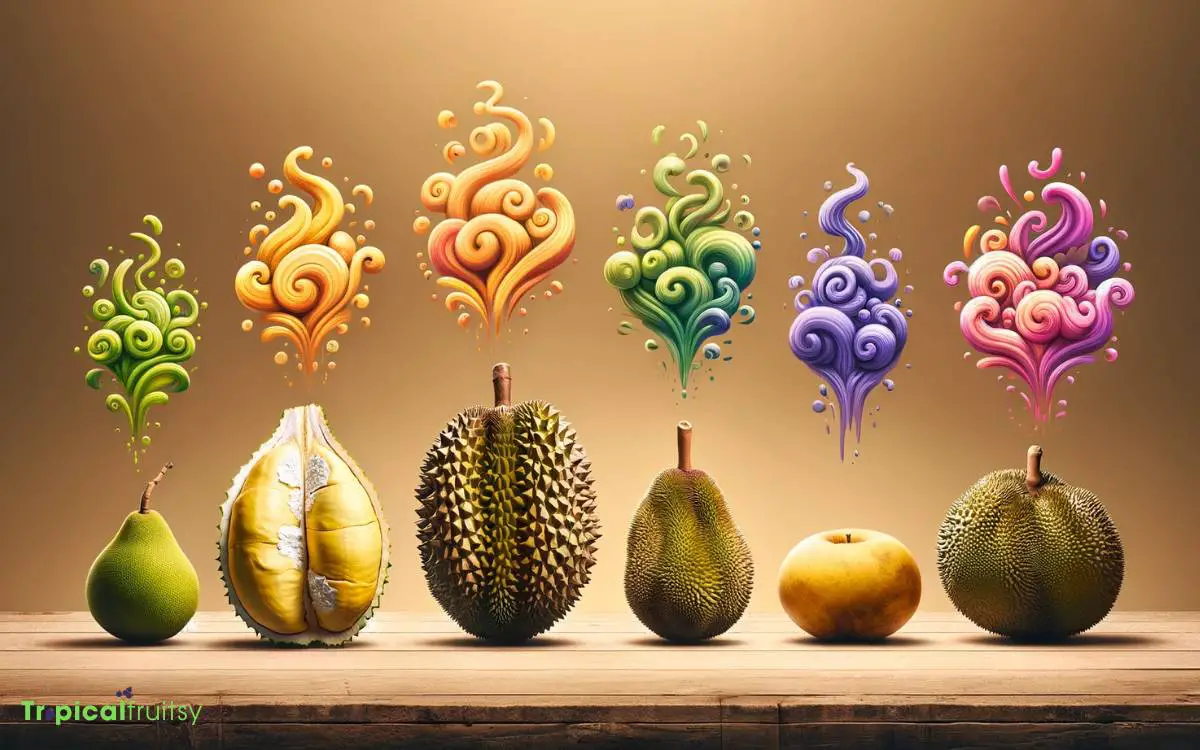
While durian is often cited as the smelliest fruit, it is not without competition in the broader category of malodorous foods.
Surströmming, a type of fermented fish from Sweden, is notorious for its potent aroma, which some compare to that of rotting food.
Similarly, Kiviak and Hakarl, traditional delicacies made from aged auk birds and cured shark respectively, are both recognized for their strong and challenging scents.
Surströmming: Fermented Fish
The pungency of surströmming, a Swedish delicacy of fermented herring, presents a formidable challenge to durian’s reputation as the smelliest fruit.
While durian is known for its potent aroma, surströmming carries a distinctively sharp and acidic scent that emanates from the Baltic Sea herring fermented in just enough salt to prevent it from rotting.
This traditional dish is often eaten outdoors due to its overpowering odor. The briny and rancid smell of surströmming can induce visceral reactions, from gagging to outright nausea.
Its aroma is so aggressive that it has been banned on certain airlines and in apartment complexes.
Despite its notorious stench, surströmming is cherished for its unique taste and cultural significance in Sweden.
Analyzing the sensory impact of surströmming requires a recognition of its culinary context and the subjective nature of olfactory experiences.
Kiviak: Auk Birds Delicacy
Often overlooked in discussions of malodorous foods, kiviak, a traditional Inuit delicacy made by fermenting auk birds in sealskin, stands as a pungent rival to durian’s olfactory challenge.
This indigenous dish is crafted through a methodical process where small arctic birds, known as auks, are preserved whole in the hollowed-out body of a seal.
The seal’s skin acts as a fermenting vessel over several months, even up to a year, in which the birds undergo enzymatic breakdown.
This fermentation produces a unique scent profile that is highly esteemed within the Inuit culture but may be startling and challenging for unaccustomed olfactory senses.
Analytically, the odor produced by kiviak is a complex amalgamation of marine and gamey notes, which underscores the diversity of naturally fermented foods that elicit strong sensory reactions.
Hakarl: Cured Shark Staple
Transitioning from the astringent odors of fermented auk to another unconventional delicacy, hákarl emerges as a notorious Icelandic dish, comprising cured shark known for its sharp, ammonia-laden aroma that can rival the pungent scent of durian.
The preparation of hákarl involves fermenting Greenland shark or other sleeper shark species, which are naturally toxic; the fermentation process renders the meat safe to eat. Its sensory impact is significant and polarizing.
The scent of hákarl has been likened to cleaning products, evoking a visceral reaction of repulsion.
Eating hákarl often initiates a psychological battle against instinctual revulsion, testing the eater’s resolve. The taste lingers, leaving a potent reminder of the encounter with this challenging Icelandic fare.
Analyzing such unique food items raises questions about cultural taste preferences. This segues into considering durian’s global reception and bans, where cultural subjectivity dictates acceptability.
Durian’s Global Reception and Bans

Many cultures have embraced durian for its unique flavor, yet several public transport systems and hotels across Asia have implemented strict bans due to its pungent odor. This dichotomy in acceptance underscores the polarizing nature of the fruit.
The bans are not merely anecdotal; they are codified in various regulations, underscoring the profound impact of the fruit’s aroma on shared public spaces.
In Singapore, for instance, durian is prohibited on the Mass Rapid Transit (MRT) system, a policy that is strictly enforced, reflecting a methodical approach to maintaining a certain standard of public comfort.
Similarly, numerous hotels in Thailand and Malaysia display signs prohibiting durian on their premises.
These preemptive measures indicate a recognition of the fruit’s potential to significantly alter the environment it inhabits.
The Surprising Benefits of Durian
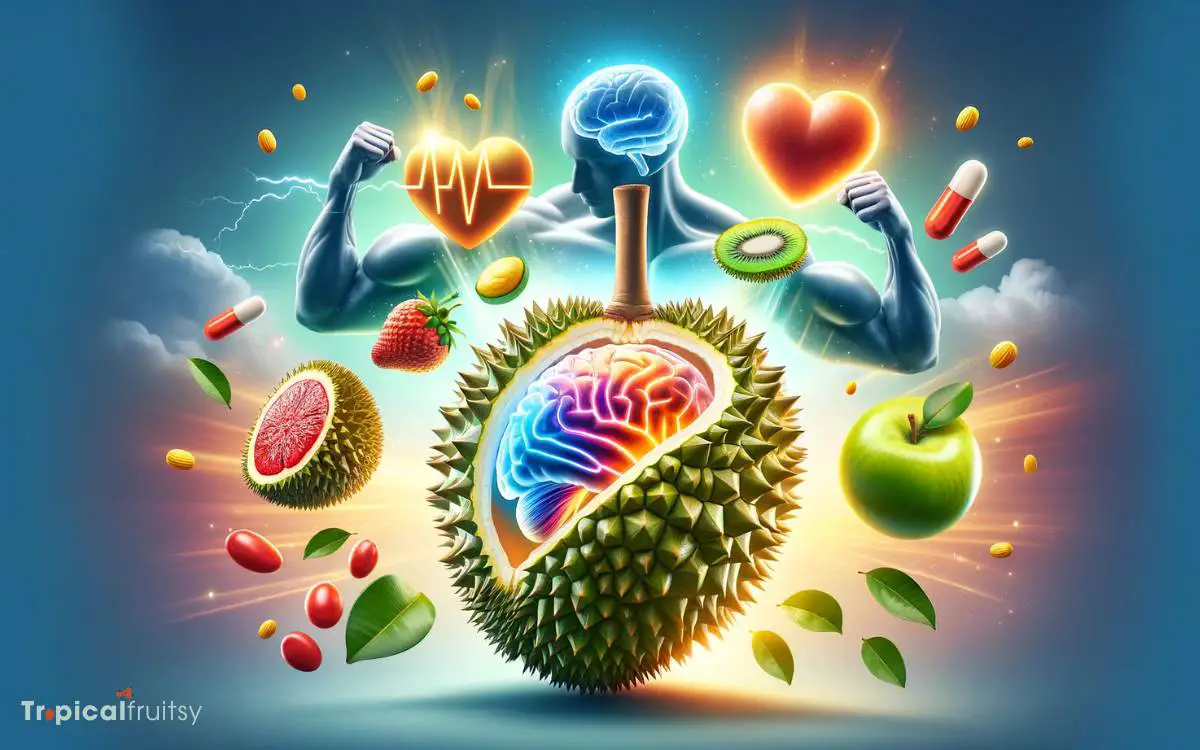
Despite its notorious odor, durian is rich in nutrients, offering a myriad of health benefits ranging from improved digestion to enhanced energy levels.
This tropical fruit is not only a treasure trove of vitamins and minerals but also contains compounds that can potentially influence various aspects of human health.
- Heartfelt Comfort: Rich in potassium and fiber, durian can help maintain blood pressure levels, offering solace to those managing hypertension.
- Mental Clarity: Durian provides thiamine, a vitamin essential for cognitive function, invoking a sense of mental sharpness and focus.
- Joyful Vigor: With its high caloric content and natural sugars, durian can give an immediate energy boost, uplifting the spirits of the fatigued.
Analyzing the nutritional profile of durian reveals its substantial contribution to a balanced diet, suggesting that the fruit’s health advantages may well compensate for its pungent smell.
Conclusion
Amidst the pantheon of pungent fruits, durian reigns supreme, its scent as divisive as it is notorious.
Through the prisms of cultural context, biochemical composition, and subjective testimony, one discerns the multifaceted nature of this tropical delicacy.
As the world grapples with its olfactory impact, the paradox of durian unfolds: an embodiment of both revulsion and allure, challenging the senses while offering a trove of nutritional rewards.

